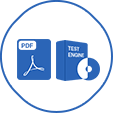Last Update 23 hours ago Total Questions : 286
The Oracle Database Administration II content is now fully updated, with all current exam questions added 23 hours ago. Deciding to include 1z0-083 practice exam questions in your study plan goes far beyond basic test preparation.
You'll find that our 1z0-083 exam questions frequently feature detailed scenarios and practical problem-solving exercises that directly mirror industry challenges. Engaging with these 1z0-083 sample sets allows you to effectively manage your time and pace yourself, giving you the ability to finish any Oracle Database Administration II practice test comfortably within the allotted time.
Choose three. Which three actions are mandatory post database upgrade?
RMAN is connected to a target database instance and an auxilary instance. You execute 3625the command: RMAN> DUPLICATE TARGET DATABASE TO dupdb FROM ACTIVE DATABASE SECTION SIZE 1G; What is the outcome?
Which are three of the steps taken by Database Configuration Assistant (DBCA) to clone a remote pluggable database (PDB) starting from Oracle 19c?
choose three Identify three reasons for using a recovery catalog with Recovery Manager (RMAN).
Identify three benefits of Unified Auditing.
Choose the best answer. Which should be tuned first when doing a performance tuning exercise for an Oracle Database environment?
Choose two. Which two are true about the Program Global Area (PGA) and its management in an Oracle database instance?

